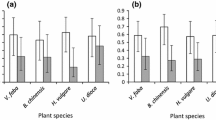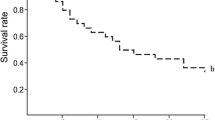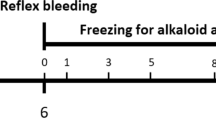Abstract
Egg predation and cannibalism are believed to be common phenomena among many species of aphidophagous predatory ladybird beetles despite the presence of alkaloid based defensive chemicals in all life stages. We identified defensive chemicals from eggs of three congeneric species, one introduced into North America (Coccinella septempunctata L.), and two native (C. transversoguttata richardsoni Brown, and C. novemnotata Herbst), and examined the effects of ingested defensive chemicals on first instars. Ingested congeneric alkaloids were not toxic to first instars, likely because the three congeners produce the same principal alkaloids, precoccinelline and coccinelline, in similar amounts. First instars of the three congeners accumulated alkaloids ingested through egg cannibalism and congeneric predation. Egg consumption doubled the amount of alkaloids in first instars when they fed on conspecific or congeneric eggs, in comparison to a pea aphid diet. No detrimental effects of ingested congeneric alkaloids on development or survival of first instars were observed among these congeners. Chemical defenses of eggs are therefore not likely to be important in favoring the invasive species, C. septempunctata, in interactions with these native congeneric species. Because the invasive species is the most aggressive predator, having the same types of alkaloids may facilitate disproportionate intraguild predation on native congeners by C. septempunctata thereby potentially enhancing the invasion success of this introduced species.




Similar content being viewed by others
References
Alyokhin A, Sewell G (2004) Changes in a lady beetle community following the establishment of three alien species. Biol Invasions 6:463–471
Angalet GW, Tropp JM, Eggert AN (1979) Coccinella septempunctata in the United States: recolonizations and notes on its ecology. Environ Entomol 8:896–901
Ayer WA, Bennett MJ, Browne LM, Purdham JT (1976) Defensive substances of Coccinella transversoguttata and Hippodamia caseyi, ladybugs indigenous to western Canada. Can J Chem 54:1807–1813
Callaway RM, Ridenour WM (2004) Novel weapons: invasive success and the evolution of increased competitive ability. Front Ecol Environ 2:436–443
Cappuccino N, Arnason JT (2006) Novel chemistry of invasive exotic plants. Biol Lett 2:189–193
Cottrell TE (2004) Suitability of exotic and native lady beetle eggs (Coleptera: Coccinellidae) for development of lady beetle larvae. Biol Control 31:362–371
Elliot NC, Kieckhefer R, Kauffmann W (1996) Effects of an invading coccinellid on native coccinellids in an agricultural landscape. Oecologia 105:537–544
Evans EW (2004) Habitat displacement of North American ladybirds by an introduced species. Ecology 85:637–647
Hautier L, Gregoire JC, de Schauwers J, Martin GS (2008) Intraguild predation by Harmonia axyridis on coccinellids revealed by exogenous alkaloid. Chemoecology 18:191–196
Hodek I, Michaud JP (2008) Why is Coccinella septempunctata so successful? (A point-of-view). Eur J Entomol 105:1–12
Hoki E, Losey J, Ugine TA (2014) Comparing the consumptive and non-consumptive effects of a native and introduced lady beetle on pea aphids (Acyrthosiphone pisum). Biol Control 70:78–84
Kajita Y, Evans EW (2010) Alfalfa fields promote high reproductive rate of an invasive predatory lady beetle. Biol Invasions 12:2293–2302
Kajita Y, Obrycki JJ, Sloggett JJ, Haynes KF (2010) Intraspecific alkaloid variation in ladybird eggs and its effects on con- and heterospecific intraguild predators. Oecologia 163:313–322. doi:10.1007/s00442-009-1551-2
Kajita Y, O’Neill EM, Zheng Y, Obrycki JJ, Weisrock DW (2012) The molecular signature of human introduction efforts in an invasive ladybeetle. Mol Ecol 21:5473–5483. doi:10.1111/mec.12059
King AG, Meinwald J (1996) Review of the defensive chemistry of coccinellids. Chem Rev 96:1105–1122
Krafsur ES, Obrycki JJ, Harwood JD (2005) Comparative genetic studies of native and introduced Coccinellidae in North America. Eur J Entomol 102:469–474
Losey J, Perlman J, Kopco J, Ramsey S, Hesler L, Evans E, Allee L, Smyth R (2012) Potential causes and consequences of decreased body size in field populations of Coccinella novemnotata. Biol Control 61:98–103
Lost Ladybug Project, http://www.lostladybug.org/
Louda SM, Pemberton RW, Johnson MT, Follet PA (2003) Nontarget effects-The achilles’ heel of biological control? Retrospective analyses to reduce risk associated with biocontrol introductions. Annu Rev Entomol 48:365–396
Lucas E (2005) Intraguild predation among aphidophagous predators. Eur J Entomol 102:351–364
Osawa N (1989) Sibling and non-sibling cannibalism by larvae of a lady beetle Harmonia axyridis Pallas (Coleoptera: Coccinellidae) in the field. Res Popul Ecol 31:153–160
Osawa N (1992a) A life table of the ladybird beetle Harmonia axyridis Pallas (Coleoptera, Coccinellidae) in relation to the aphid abundance. Jpn J Entomol 60:575–579
Osawa N (1992b) Sibling cannibalism in the ladybird beetle Harmonia axyridis: fitness consequences for mother and offspring. Res Popul Ecol 34:45–55
Pervez A, Gupta AK, Omkar (2006) Larval cannibalism in aphidophagous ladybirds: influencing factors, benefits and costs. Biol Control 38:307–313
Rieder JP, Newbold TAS, Sato S, Yasuda H, Evans EW (2008) Intra-guild predation and variation in egg defence between sympatric and allopatric populations of two species of ladybird beetles. Ecol Entomol 33:53–58
SAS 9.3 (2012) SAS Institute, Inc., Cary, North Carolina, USA
Sato S, Dixon AFG (2004) Effect of intraguild predation on the survival and development of three species of aphidophagous ladybirds. Agric For Entomol 6:21–24
Sato S, Dixon AFG, Yasuda H (2003) Effect of emigration on cannibalism and intraguild predation in aphidophagous ladybirds. Ecol Entomol 28:628–633
Shellhorn NA, Andow DA (1999) Cannibalism and interspecific predation: role of oviposition behavior. Ecol Appl 9:418–428
Sloggett JJ (2005) Are we studying too few taxa? Insights from aphidophagous ladybird beetles (Coleoptera: Coccinellidae). Eur J Entomol 102:391–398
Sloggett JJ, Davis AJ (2010) Eating chemically defended prey: alkaloid metabolism in an invasive ladybird predator of other ladybirds (Coleoptera: Coccinellidae). J Exp Biol 213:237–241. doi:10.1242/ jeb.037127
Sloggett JJ, Lorenz MW (2008) Egg composition and reproductive investment in aphidophagous ladybird beetles (Coccinellidae: Coccinellini): egg development and interspecific variation. Physiol Entomol 33:200–208
Sloggett JJ, Haynes KF, Obrycki JJ (2009) Hidden costs to an invasive intraguild predator form chemically defended native prey. Oikos 118:1396–1404. doi:10.1111/j.1600-0706.2009.17407.x
Snyder WE, Clevenger GM, Eigenbrode SD (2004) Intraguild predation and successful in invasion by introduced ladybird beetles. Oecologia 140:559–565. doi:10.1007/s00442-004-1612-5
Takahashi K (1989) Intra- and inter-specific predations of lady beetles in spring alfalfa fields. Jpn J Appl Entomol Zool 57:199–203
Turnock WJ, Wise IL, Matheson FO (2003) Abundance of some native coccinellines (Coleoptera: Coccinellidae) before and after the appearance of Coccinella septempunctata. Can Entomol 135:391–404
Tursch B, Daloze D, Dupont M, Hootele C, Kaisin M, Pasteels JM, Zimmermann D (1971a) Coccinelline, the defensive alkaloids of the beetle Coccinella septempunctata. Chimia 25:307–308
Tursch B, Daloze D, Dupont M, Pasteels JM, Tricot M-C (1971b) A defensive alkaloid in a carnivorous beetle. Experientia 27:1380–1381
Yasuda H, Shinya K (1997) Cannibalism and interspecific predation in two predatory ladybirds in relation to prey abundance in the field. Entomophaga 42:153–163
Yasuda H, Evans EW, Kajita Y, Urakawa K, Takizawa T (2004) Asymmetric larval interactions between introduced and indigenous ladybirds in North America. Oecologia 141:722–731
Acknowledgments
We thank S. Stamper, S. Bessin, S. Thompson, A. Taman, C. Fox, and B. Wallin, for insect collections, providing facilities and experimental help. We also thank L. Hesler, USDA-ARS, Brookings, SD, for providing us adults of Coccinella novemnotata for this study. This experiment was supported by USDA-NRI (2007–02286) and NSF award (DEB-1429163). We also thank two anonymous reviewers and the editor for their very helpful comments on the manuscript. The information reported in this paper (NO.14-08-031) is part of a project of the Kentucky Agricultural Experiment Station and is published with the approval of the Director.
Author information
Authors and Affiliations
Corresponding author
Rights and permissions
About this article
Cite this article
Kajita, Y., Obrycki, J.J., Sloggett, J.J. et al. Do Defensive Chemicals Facilitate Intraguild Predation and Influence Invasion Success in Ladybird Beetles?. J Chem Ecol 40, 1212–1219 (2014). https://doi.org/10.1007/s10886-014-0513-2
Received:
Revised:
Accepted:
Published:
Issue Date:
DOI: https://doi.org/10.1007/s10886-014-0513-2




